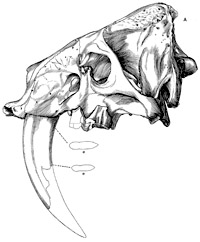Museum, University of Nebraska State
Date of this Version
2004
Document Type
Article
Citation
Kenneth N. Geluso & Keith Geluso, Mammals of Carlsbad Caverns National Park, New Mexico, Bulletin of the University of Nebraska State Museum, Volume 17 (2004). 192pp
Abstract
Carlsbad Cavern was established as a national park on 14 May 1930, after being designated as a national monument for nearly seven years. The park is located in southeastern New Mexico, and today it encompasses 189.3 km2 (73.1 mi2). Eighty-eight percent of the park lies in the rugged Guadalupe Mountains, while 12% is located on relatively flat land along the base of the mountains. The park contains a variety of habitats ranging from desert scrub at the lowest elevations to coniferous woodlands on the highest summits. Five months after Carlsbad Cavern was declared a national monument, Vernon Bailey conducted a survey of animals in the cavern and surrounding lands. The survey lasted from March to May 1924, and results were published in a monograph titled Animal Life of the Carlsbad Cavern (Bailey 1928). During his survey, Bailey documented 39 species of mammals within the present-day boundaries of Carlsbad Caverns National Park. Approximately 50 years after Bailey’s survey, we conducted surveys of mammals in the park (1973-2000), and results of our surveys are the basis for the present volume. Herein we also report and summarize information from Bailey’s book, other scientific literature, museum specimens, field notes of previous investigators, park documents, and interviews with people associated with the park.
Since Bailey’s survey in 1924, several species of mammals have been extirpated from the park, several species are now present due to introductions by humans, and many others have been confirmed in the park that were not detected by Bailey. In recent years (1949-2000), 63 species of mammals (excluding humans and their domestic animals) have been documented in the park—1 shrew, 15 bats, 2 lagomorphs, 27 rodents, 13 carnivores, and 5 ungulates. For 58 species, records exist from 1990 to 2000. The most recent records for the remaining five species are as follows: western spotted skunk (Spilogale gracilis) 1985, pronghorn (Antilocapra americana) 1965, pocketed free-tailed bat (Nyctinomops femorosaccus) 1956, big free-tailed bat (Nyctinomops macrotis) 1956, and house mouse (Mus musculus) 1949. The present volume includes a descriptive narrative for each of the 63 contemporary species of mammals. We also provide accounts for five species that were extirpated during the past 150 years and for another 11 species with uncertain status. For contemporary species, accounts include detailed information on habitat, reproduction, and collection localities. A distribution map also is available for most species. In addition, we discuss changes in population size or shifts in distribution for the following 12 species: Brazilian free-tailed bat (Tadarida brasiliensis), black-tailed prairie dog (Cynomys ludovicianus), banner-tailed kangaroo rat (Dipodomys spectabilis), Merriam’s kangaroo rat (D. merriami), whitefooted mouse (Peromyscus leucopus), southern plains woodrat (Neotoma micropus), house mouse (Mus musculus), collared peccary (Pecari tajacu), elk (Cervus canadensis), pronghorn (Antilocapra americana), bighorn sheep (Ovis canadensis), and aoudad (Ammotragus lervia). Carlsbad Caverns National Park is one of the most ecologically diverse parks in the United States, and we hope that information in this volume will stimulate additional research on mammals and other organisms in the park. Understanding the distribution, abundance, and types of plants and animals on public lands is important because it provides necessary information for making sound management decisions and for designing accurate interpretive programs for education of the general public.
Included in
Entomology Commons, Geology Commons, Geomorphology Commons, Other Ecology and Evolutionary Biology Commons, Paleobiology Commons, Paleontology Commons, Sedimentology Commons


Comments
Copyright © by the University of Nebraska State Museum, 2004.